Effect of Different Cantilever Lengths in Polyether Ether Ketone Prosthetic Framework in All-on-Four Technique on Stress Distribution: A Three-Dimensional (3D) Finite Element Analysis
- PMID: 39735106
- PMCID: PMC11671772
- DOI: 10.7759/cureus.74544
Effect of Different Cantilever Lengths in Polyether Ether Ketone Prosthetic Framework in All-on-Four Technique on Stress Distribution: A Three-Dimensional (3D) Finite Element Analysis
Abstract
Background: Determining the distal cantilever length in All-on-Four (All-on-4) implant-supported prostheses is a major factor in the long-term success of these prostheses. The difference in mechanical properties of materials used in the fabrication of these prostheses, such as polyether ether ketone (PEEK), may have an impact on the determination of the cantilever length that best distributes stress.
Aim: To study the distribution of stress in All-on-4 mandibular prostheses in the bone, implants, and framework according to difference cantilever length in PEEK prosthetic framework using three-dimensional finite element analysis.
Materials and methods: A three-dimensional (3D) model of an edentulous mandible was constructed, implants and abutments models were designed by the All-on-4 concept, and two frameworks were constructed from PEEK with different cantilever lengths of 10 and 15 mm. Two study groups were created. Occlusal oblique forces of 600N were applied from the right side at a 45-degree angle, and finite element analysis was performed to obtain the stress distribution in the bone, implants, and framework.
Results: At cantilever length of 10 mm, in the PEEK model, this study found an increase in stress compared to PEEK model at cantilever length of 15 mm in the cortical bone and implants and framework, but PEEK models showed a similar distribution of stress in the spongy bone.
Conclusions: Decreasing the cantilever length in the PEEK model will increase the stress. PEEK models showed deformation of the structure material.
Keywords: all on 4; cantilever length; finite element analysis; peek; stress.
Copyright © 2024, Almjaddr et al.
Conflict of interest statement
Human subjects: All authors have confirmed that this study did not involve human participants or tissue. Animal subjects: All authors have confirmed that this study did not involve animal subjects or tissue. Conflicts of interest: In compliance with the ICMJE uniform disclosure form, all authors declare the following: Payment/services info: All authors have declared that no financial support was received from any organization for the submitted work. Financial relationships: All authors have declared that they have no financial relationships at present or within the previous three years with any organizations that might have an interest in the submitted work. Other relationships: All authors have declared that there are no other relationships or activities that could appear to have influenced the submitted work.
Figures


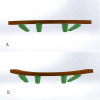
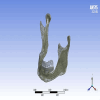



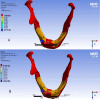

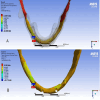
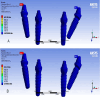
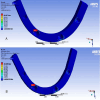
Similar articles
-
Biomechanical analysis of All-on-4 implant supported framework using different materials across various clinical practice.BMC Oral Health. 2025 Apr 12;25(1):552. doi: 10.1186/s12903-025-05928-0. BMC Oral Health. 2025. PMID: 40221683 Free PMC article.
-
[Three-dimensional finite element analysis of different framework materials in implant-supported fixed mandibular prosthesis].Zhonghua Kou Qiang Yi Xue Za Zhi. 2021 Feb 9;56(2):190-195. doi: 10.3760/cma.j.cn112144-20200430-00240. Zhonghua Kou Qiang Yi Xue Za Zhi. 2021. PMID: 33557504 Chinese.
-
Biomechanical Comparison of Different Implant Inclinations and Cantilever Lengths in All-on-4 Treatment Concept by Three-Dimensional Finite Element Analysis.Int J Oral Maxillofac Implants. 2018 Jan/Feb;33(1):64-71. doi: 10.11607/jomi.6201. Int J Oral Maxillofac Implants. 2018. PMID: 29340344
-
Influence of different polymeric materials of implant and attachment on stress distribution in implant-supported overdentures: a three-dimensional finite element study.BMC Oral Health. 2025 Jan 31;25(1):166. doi: 10.1186/s12903-025-05440-5. BMC Oral Health. 2025. PMID: 39885486 Free PMC article.
-
Comparison of Stress Distribution and Deformation of Four Prosthetic Materials in Full-mouth Rehabilitation with Implants: A Three-dimensional Finite Element Study.J Contemp Dent Pract. 2020 Nov 1;21(11):1210-1217. J Contemp Dent Pract. 2020. PMID: 33850065
Cited by
-
Comparison of Surface Strains of Polymeric Frameworks for Fixed Implant-Supported Prostheses: A Digital Image Correlation Study.Materials (Basel). 2025 Apr 9;18(8):1700. doi: 10.3390/ma18081700. Materials (Basel). 2025. PMID: 40333280 Free PMC article.
-
Effect of different cross sections of polyetheretherketone splinting bars in maxillary All-on-4® implant supported interim prosthesis: finite element analysis study.BMC Oral Health. 2025 Jul 28;25(1):1268. doi: 10.1186/s12903-025-06542-w. BMC Oral Health. 2025. PMID: 40721792 Free PMC article.
References
-
- Quality of life of implant-supported overdenture and conventional complete denture in restoring the edentulous mandible: a systematic review. Zhang L, Lyu C, Shang Z, Niu A, Liang X. Implant Dent. 2017;26:945–950. - PubMed
-
- Biomechanical comparison of different implant inclinations and cantilever lengths in all-on-4 treatment concept by three-dimensional finite element analysis. Ozan O, Kurtulmus-Yilmaz S. Int J Oral Maxillofac Implants. 2018;33:64–71. - PubMed
-
- Applications of polyetheretherketone (PEEK) in oral implantology and prosthodontics. Najeeb S, Zafar MS, Khurshid Z, Siddiqui F. J Prosthodont Res. 2016;60:12–19. - PubMed
LinkOut - more resources
Full Text Sources
